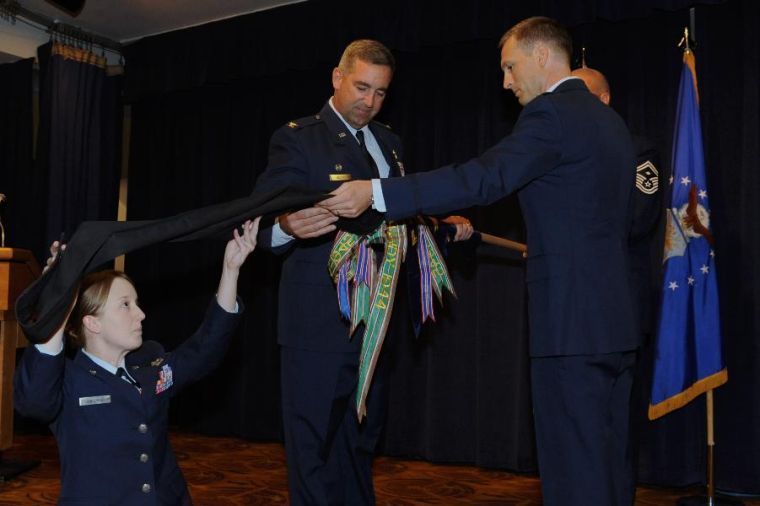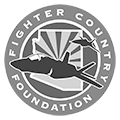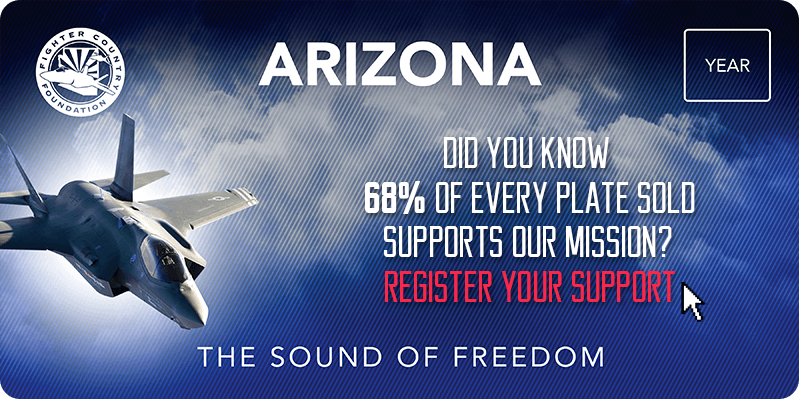
Col. John Hanna, left, 56th Operation Group commander, unfurls the 61st Fighter Squadron banner with incoming commander Lt. Col. Michael Edner, during the reactivation ceremony Oct. 25.
Photo by Airman 1st Class Pedro Mota, USAF
At an Oct. 25 ceremony, Luke Air Force Base reactivated the 61st Fighter Squadron, designating the unit as the first of six squadrons planned for training in the F-35 Lightning II stealth fighter jet.
More than 150 family members, pilots and community members were present at the ceremony, which was held at Club Five Six on the base.
Also in attendance were Brig. Gen. Michael Rothstein, 56th Fighter Wing commander, and Col. John Hanna, 56th Operations Group commander, who was the presiding officer.
In his opening remarks at the rededication of the squadron, Hanna praised the incoming commander, Lt. Col. Michael Ebner, for his leadership and skill as a pilot.
He added that after all the cutbacks involving fighter squadrons and aircraft inventories since the mid-1980s, it was a good feeling to reactivate a squadron instead of shutting one down.
The Air Force is using experienced fighter pilots already flying the F-35 jets and they will use similar strategy to quickly train more F-35 pilots.
“They’re coming from flying an F-15 and F-16, so they are experienced guys,” Ebner said. “The minimum flying experience for pilots coming into the F-35 right now is 750 hours in a fighter-type aircraft.”
By 2015, the newly certified instructors will begin training pilots who will be deployed to combat units around the world to take control of F-35s as fast as Lockheed Martin Aeronautics Co. can produce them.
Most of the training will be conducted west of Luke at military ranges in southern Arizona and southern California.
At the ceremony, Hanna presented the squadron guidon (military flag that designates the unit) to Ebner. That signified Ebner’s official assumption of command of the squadron.
Ebner said the 61st FS will stand ready to accomplish any mission that may come along.
“I’m proud to be part of a squadron with such a rich history,” he said. “Our work is just beginning. We will train the finest F-35 pilots in the world, and it’s vital that we work as a team to do that.”
Once the squadron is fully staffed, it will have a pilot for each jet and approximately 300 ground personnel for plane maintenance.
 The squadron, called the “Top Dogs,” was stationed at Luke from 1994 through 2012. It was a training group for F-16 pilots and the new squad will train F-35 pilots.
The squadron, called the “Top Dogs,” was stationed at Luke from 1994 through 2012. It was a training group for F-16 pilots and the new squad will train F-35 pilots.
Luke Air Force Base has trained pilots of F-16s and F-15s for almost 72 years and secured the new training in 2012.
The first F-35 will arrive at the base in January when the full training program is set to begin.
The 61st FS, which was inactivated most recently in 2010, will be the first squadron at Luke to fly the F-35A Lightning II, which is the Air Force’s newest fighter jet. The first jet is expected to arrive early next year, and a total of 16 to 18 jets are scheduled to be at Luke by the end of 2014.
Overall, Luke will serve as the permanent training base for 144 of the jet planes that defense analysts say will be crucial to U.S. military operations for the next 40 years. The planes can reach Mach 1.6, or about 1,200 mph, and Ebner said they are remarkably easy to handle.
After the first squadron arrives in January, the second set of jets is scheduled to arrive at Luke in early 2015.
BY DARRELL JACKSON, Staff Writer, Glendale Star








